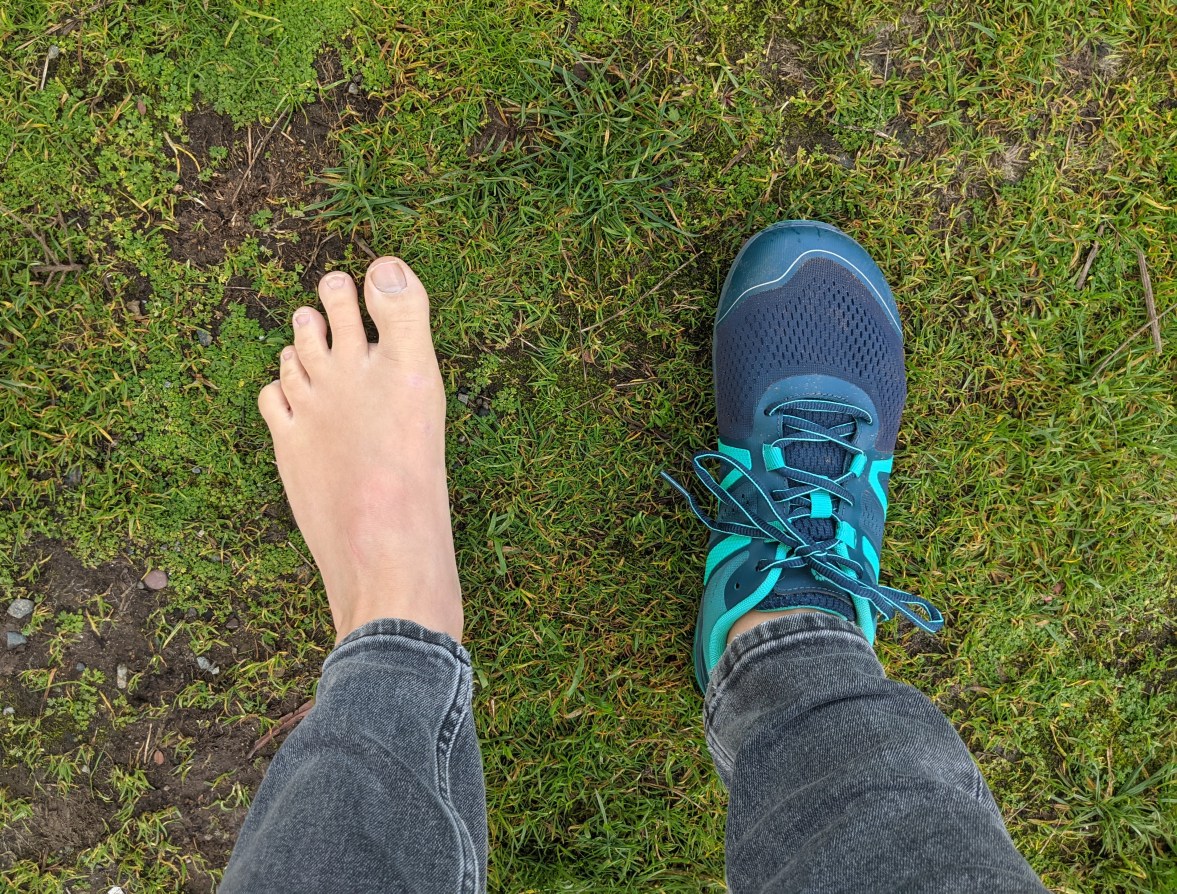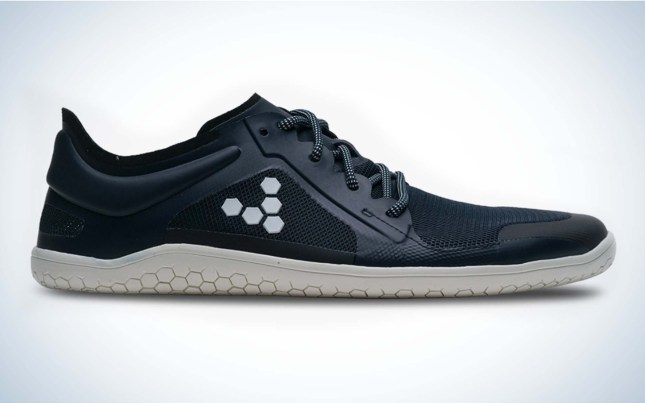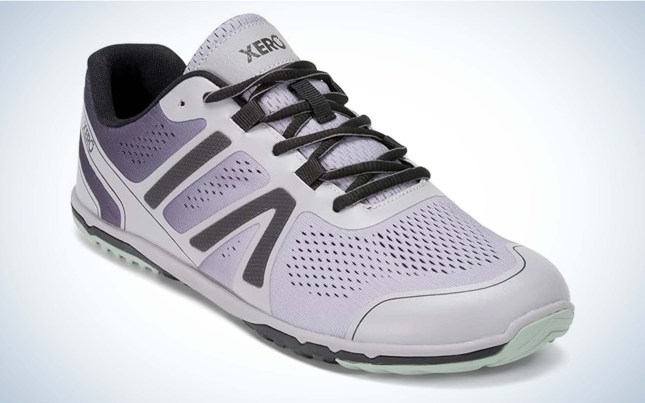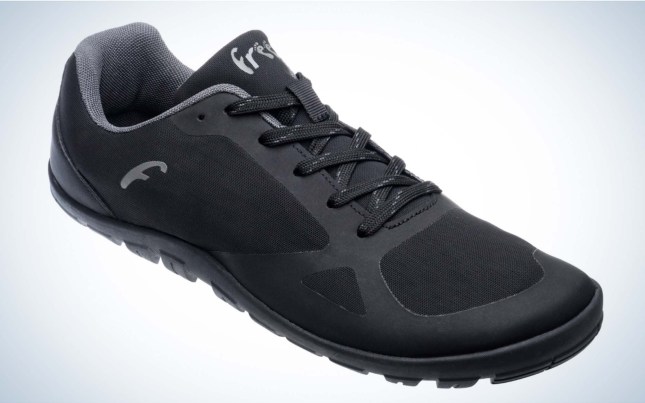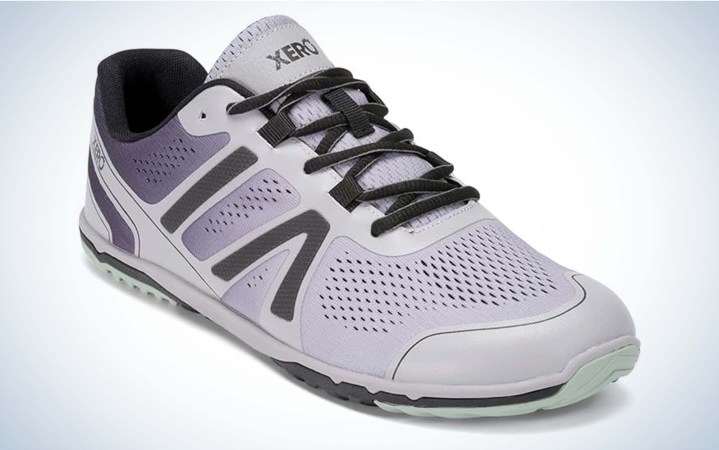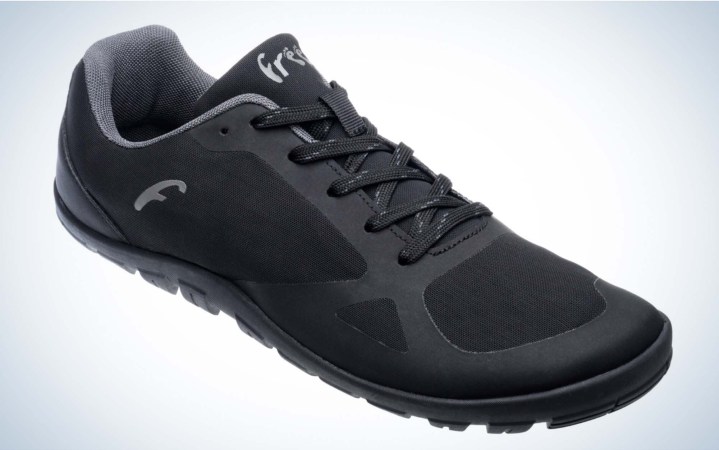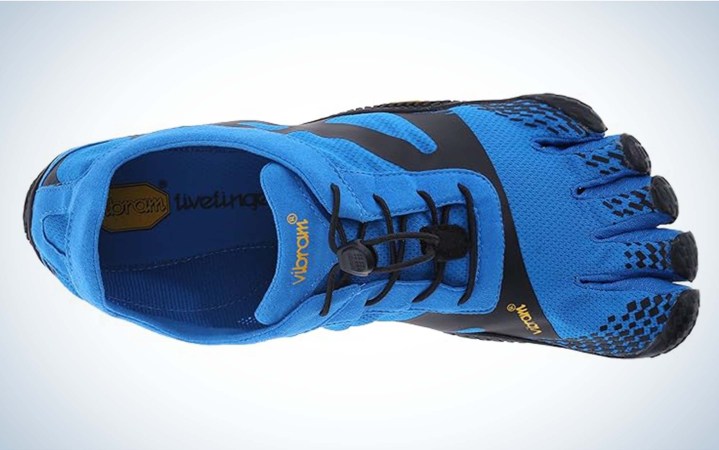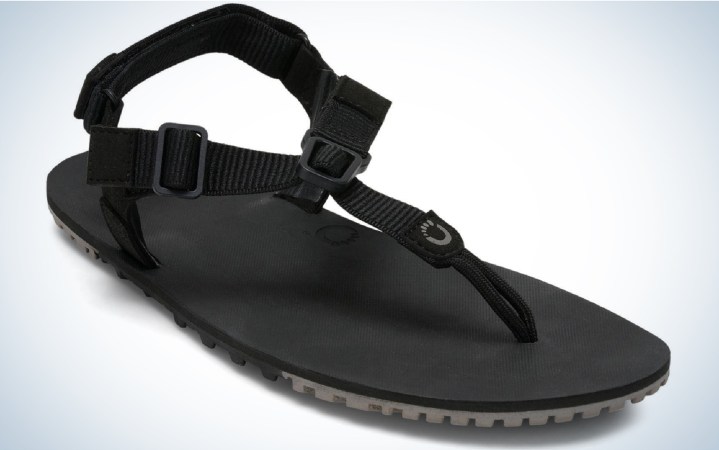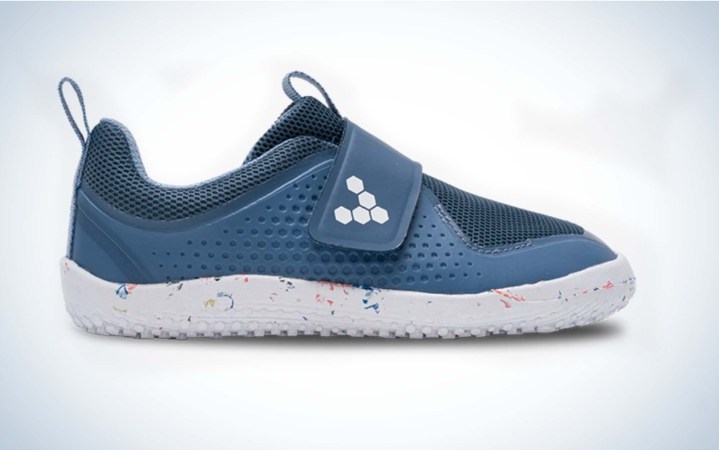We may earn revenue from the products available on this page and participate in affiliate programs. Learn More ›
More and more people are discovering the benefits of integrating barefoot shoes into their daily routines. Whether it’s improving your balance at the gym, strengthening the muscles of your feet on daily walks, or improving your posture while running, there are a myriad of benefits to using barefoot shoes. But new terminology can also be daunting: stack height, zero drop, toe splay. To help you find your first pair, I’ve broken down the pros and cons of some of the best barefoot shoes from major brands with the help of experts.
Best Overall: Vivobarefoot Primus III (Men’s) (Women’s)
↓ Jump to Review
Most Comfortable: Xero HFS II (Men’s) (Women’s)
↓ Jump to Review
Best for Wide Feet: Freet Feldom (Unisex)
↓ Jump to Review
Best Ground Feel: Vibram FiveFingers KSO EVO (Men’s) (Women’s)
↓ Jump to Review
Best Sandal: Xero H-Trail (Men’s) (Women’s)
↓ Jump to Review
Best for Kids: Vivobarefoot Primus Sport (Unisex)
↓ Jump to Review
How I Chose the Best Barefoot Shoes
I’ve been wearing barefoot shoes for over a decade, and have tested almost all of the major brands on the market on everything from thru-hikes to hunts, trail running to off-trail scrambles — I even own pairs for casual and formal wear. To better inform myself on the needs of barefoot shoe users across a range of experience levels and foot mechanics, I also spoke with a number of experts, including:
- Irene Davis, PT, PhD in biomechanics, president of the American College of Sports Medicine
- Nicholas Charlier, Head of Community and Education at Vivobarefoot
- Eric Orton, ultramarathon coach and co-author of Born to Run 2: The Ultimate Training Guide
- Scott Socha, pedorthist and owner of Foot RX Running
- John Wadley, VP of Product Development at Xero Shoes
What to Look for in Barefoot Shoes
With traditional shoes, there are a lot of variables to sift through. How much underfoot cushion do you want? How much of a boost in the heel feels comfortable to you? What level of arch support feels right? Do you want a rocker bottom or a swallowtail heel?
Barefoot shoes do away with all this. There is no lift at the heel and no support under the arch. A benefit to doing away with all these structural details is that we can finally focus on fit. All shoes are built around something called a “last” — essentially a foot-shaped mold. “The Coca-Cola recipe is that original last shape, and that’s why people either love or hate a shoe brand,” says John Wadley, VP of Product Development at Xero Shoes. “They either like the way that brand fits or they don’t.”

Zamberlan
Differences in Barefoot Shoe Fit
While there are differences in approach between different barefoot shoes on the market, the most noticeable difference is in how these different shoes conform to your foot.
Socha described a number of factors he looks at when fitting clients with a new shoe including comfort, length, width, volume, toe slope, and planned activity (daily versus formal versus outdoor active)
The good news is that there is a healthy variety of lasts used by various shoe manufacturers, and several of the biggest brands do an excellent job of maintaining that last shape throughout their different styles. That means that if you find a shoe that’s the perfect fit, you’ll likely be able to fit the other shoes that brand carries. The bad news is that, for now, there is very little opportunity to try on a wide selection of barefoot shoes in person. One exception to this is Socha’s store, Foot RX Running, in Asheville, North Carolina.
Vivobarefoot vs. Xero: Which is right for you?
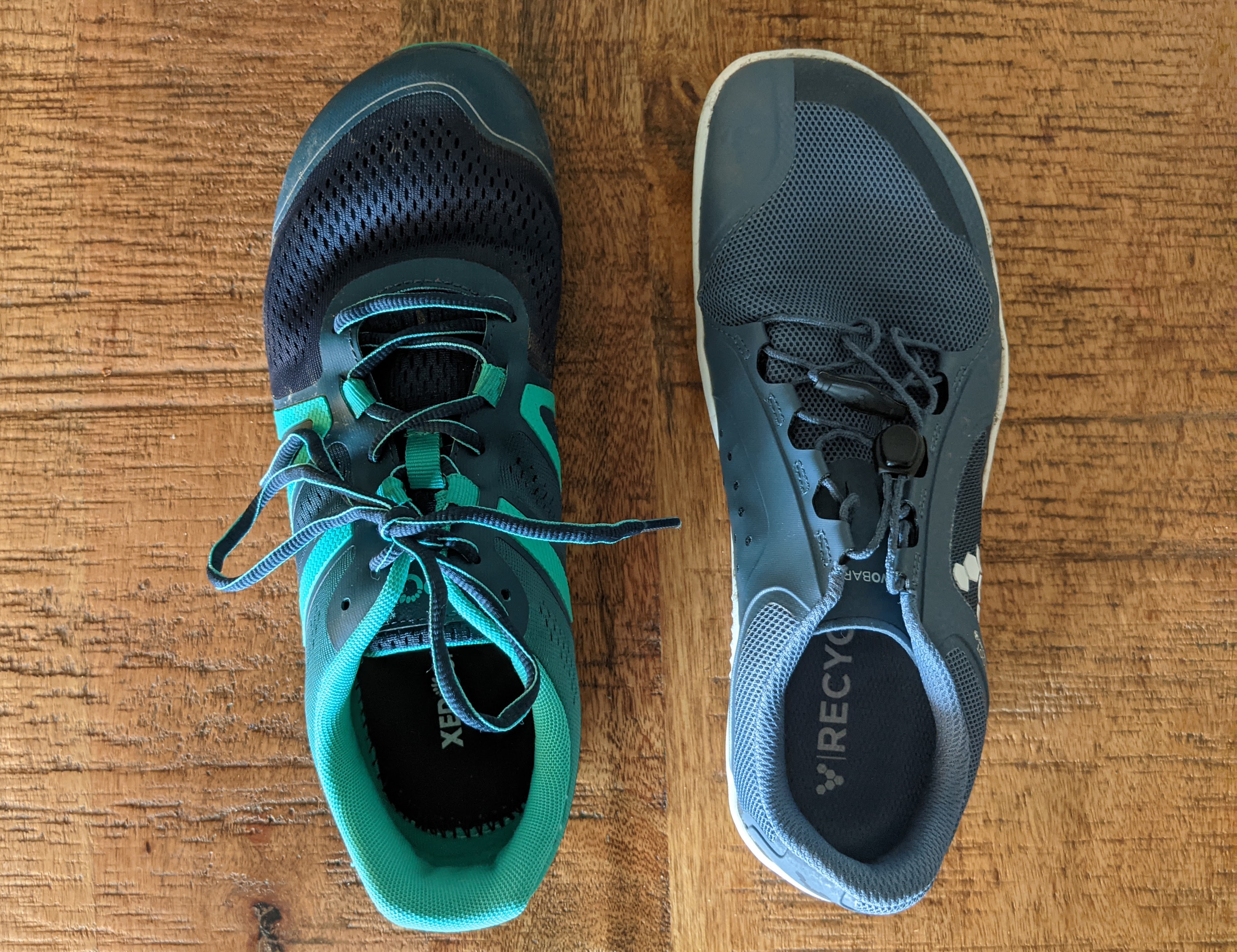
Laura Lancaster
The two biggest brands in barefoot shoes are Vivobarefoot and Xero Shoes, and Irene Davis recommends them to her physical therapy patients. Both of these are excellent choices in terms of their barefoot bonafides, but the last each uses results in a different shape that will fit your foot differently.
The Vivobarefoot last creates shoes designed for a typical foot: narrowest at the heel and fanning out toward a wide forefoot that is longest at the big toe and gently slopes down the last three toes. Xero shoes maintain more width across the length of the shoe (it does taper some) and have a less sharp curve to the toe box, which also starts closer to the third toe.
If you consider your foot to be pretty typical, you will likely gravitate toward the Vivobarefoot last. If you have a higher volume foot, more width along the entire length of your foot, or toes that are a more irregular length, you will likely find that Xeros work better for you. If, like most people, you have no idea where your feet are along this spectrum, your best bet is to try both to see which one feels best to your feet. Xero shoes can be found at an increasingly wide array of retailers; Vivobarefoots, for now, are harder to find in stores, but have a more generous return policy.
Below, I cover more of the pros and cons of each shoe, as well as other options that may work well for your particular foot shape.
The Best Barefoot Shoes: Reviews & Recommendations
Best Overall: Vivobarefoot Primus Lite III
Key Features
- Weight: 12.8 ounces
- Stack Height: 5mm (2mm base + 2mm lugs +1mm strobel layer)
- Removable 3mm insole
Pros
- Great fit for most feet
- Low stack height has a great minimalist feel
- Robust and long-lasting
- Comes with free access to their barefoot fundamentals course
Cons
- Expensive
- Doesn’t fit as well if you have higher-volume feet
- Visually identifiable as a barefoot shoe
When you talk to people who have been wearing barefoot shoes for a long time, the Vivobarefoot Primus comes up repeatedly. It’s the shoe that ticks all the boxes: it has a great foot shape, a low stack height, and is surprisingly robust. I’ve worn the FG version of this shoe (my pick for the best minimalist shoe for hiking and trail running) over 800 miles for thru-hiking and trail running, and it was just as serviceable at the end of that time as it was at the start (even if some of the lugs had worn down smoother than I would have liked). My husband and sister also wear the Vivobarefoot Primus; my daughter wears the kid’s version.
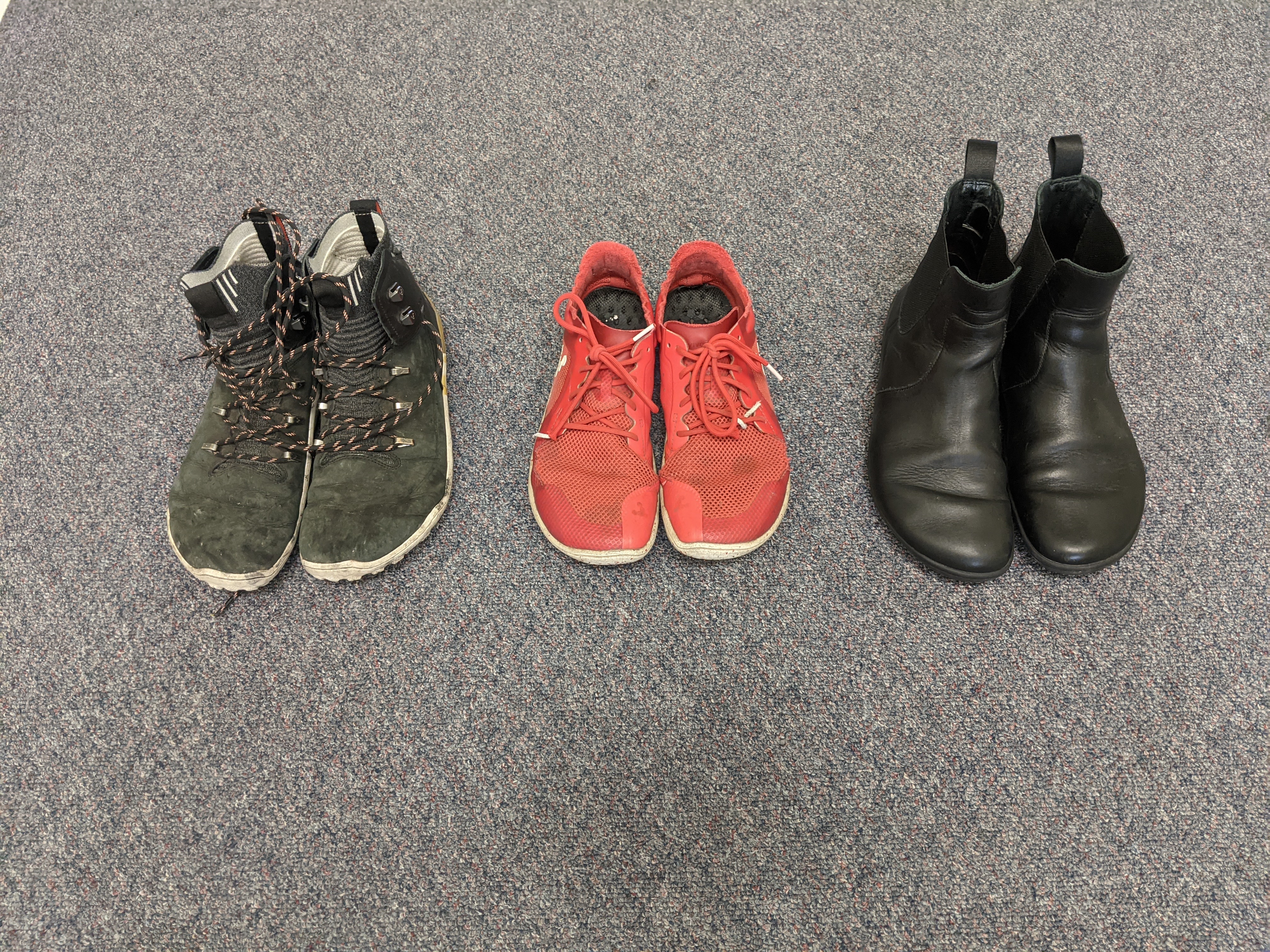
The Vivobarefoot Primus Lite is narrowest at the heel and fans out toward the toe, with a slope at the front that starts at the second toe. If you have a fairly standard foot, you’ll probably find this shoe’s fit is perfect. But if you have an unusually shaped foot — high volume or wide — then it may feel tight in certain places. (My sister, who helped me evaluate the best hiking shoes for wide feet, wears the men’s version of this shoe.) If this shoe is just a hair too tight, try taking out the insole, which increases the interior volume.
In the event the Vivobarefoot Primus Lite turns out to be your shoe of choice, I’ve got good news: Vivobarefoot has done a great job of maintaining the fit across styles. I own the Gobi Chelsea and have tested the Vivobarefoot Tracker (as well as several discontinued styles): all of these shoes fit my foot just as well as the Primus. Two exceptions to this are their newest shoe, the Motus, which is somewhat wider at the middle of the foot (it’s not a shoe you can wear sockless, either, if that’s your preference, due to some abrasive stitching around the tongue) and the Ultra Bloom water shoe, which runs extremely wide.
One of the biggest cons to these shoes is their price: they are more expensive than the comparable Xero or Vibram models. One benefit of going with this higher-priced shoe is getting access to Vivobarefoot’s “Barefoot Fundamental Course.” This online course teaches you about your feet and exercises to strengthen and stretch them, and which was recommended by the pedorthist I spoke to, Scott Socha. Also, in my experience, these shoes’ durability justifies their price tag: you’ll easily surpass the 500-mile mark that is standard with cushioned running shoes: I’ve gotten up to a 1,000 miles out of some pairs.
Most Comfortable: Xero HFS II
Key Features
- Weight: 16.6 ounces
- Stack Height: 9mm (2.5mm lugs, 2.5mm outsole, 2.5mm foam, and 1.5mm strobel layer)
- Removable 3.5mm insole
Pros
- Xero shoes fit a wider range of foot types than Vivobarefoot
- Do not look like barefoot shoes
- Have waterproof shoes and boots that are appropriate for use in the snow
Cons
- Inclusion of foam detracts a touch from the barefoot experience
While Vivobarefoot shoes are designed to fit the ideal foot, Xero shoes are designed to fit a wider range of the feet actual humans have. This shoe will almost certainly accommodate you if you have a high-volume foot, toes that are an unusual length, or a beefy mid-foot. The downside to this is that if you do have a classic foot shape, then the Xero may not conform to your foot as well; when wearing these shoes, I sometimes feel as if my foot is sliding around no matter how tightly I lace them. But don’t take my word for it: the best way to find out if the Xero or the Vivobarefoot is the right fit for your foot is to try them.

Laura Lancaster
Something unusual about most Xero shoes, including the HFS, compared to other barefoot shoes, is that they do use a very small amount of foam in their soles. When I queried Xero about this, they explained that the reason they use foam in their shoes is to provide protection against the ground without resorting to excessive use of rubber, which would make the shoe heavier. The amount of foam they use in their shoes is fairly negligible, making compression less of an issue over time: you can’t wear something like the Hoka Clifton indefinitely because the 25mm of foam will eventually compress to 12.5mm. The HFS, which has 2.5mm foam, will compress to 1.5mm, which most people are unlikely to notice. Who may notice, however, are barefoot runners accustomed to the most minimalist shoes like the Vivobarefoot and Vibram FiveFingers. Like with the fit, this ultimately comes down to personal preference, and Xero shoes were recommended by a number of barefoot experts that I spoke with. If you like the fit of the Xero shoes, but not the slight squishiness of the foam, check out either their Speedcross or Prio models, which do not include foam.
While the foam may be noticeable to some, what isn’t is these shoes in public spaces. As a gear reviewer, I’m constantly swiveling around to see what people have on, including their shoes. I can spot Vivobarefoots from down the block; they just have that barefoot look to them. Xeros? Not so much. I’m constantly surprised when I catch sight of the logo (the only true tell-tale sign). If you’re looking to try barefoot shoes, but don’t want to rock your whole aesthetic, then Xero is the way to go.
Like with Vivobarefoot, Xero has done an excellent job of maintaining the same fit across their collection.
Best for Wide Feet: Freet Feldom
Key Features
- Weight: 15.3 ounces
- Stack Height: 8mm (4mm lugs, 2mm outsole, and 2mm foam)
- Removable 2.5mm insole
Pros
- Very wide, even compared to other barefoot shoes
- Comfortable
Cons
- Last shape not maintained across the Freet lineup
A lot of barefoot shoes are wider than average: turns out when you aren’t trying to control the foot as a way to stabilize it, that opens up a lot of breathing room. As a result, these shoes can often accommodate individuals who otherwise would purchase wide-width shoes — but usually not beyond that. If you’ve got 4E feet, you’re out of luck.
I’ve tested both the Freet Feldom and the Tundra and I’ve found them both to be noticeably wider than other barefoot shoes. If you’ve tried Xero and Vivobarefoot shoes and found that they don’t accommodate the width of your foot, make this your next stop. Unfortunately, Socha shared with me that he’s found that Freet’s last is less consistent than other brands, with their trail running shoe, the Calver running on the narrow side.
Best Ground Feel: Vibram FiveFingers KSO EVO
Key Features
- Weight: 9.8 ounces
- Stack Height: 4mm (3mm outsole with 1mm sock liner)
- Removable 2mm insole
Pros
- Great ground feel
- Separates your toes
- Vibram sole is superior to the material used by Vivobarefoot and Xero
Cons
- Look pretty goofy
- Sort of a pain to put on
Vibram FiveFingers: the shoe that started it all. If you went in on barefoot shoes during a certain era, you definitely owned a pair. And while they are no longer the most popular, or most recommended, barefoot shoes on the market, there is one category where Vibram FiveFingers still smoke the competition: ground feel.
When I pull on a pair of Vibram FiveFingers, the difference is palpable. With other barefoot shoes, I can feel the undulations of the ground; with FiveFingers I can practically feel the texture. And even though the outsole is wafer thin by comparison, it’s still providing best-in-class protection. This is, after all, what Vibram is known for: making the best of the best outsoles on the market. Arguably my biggest beef with other barefoot shoes is that they don’t have Vibram outsoles, which are more rugged, more durable, and stickier.
But I still don’t typically reach for Vibram FiveFingers when heading out for a run or a hike. There are a few reasons for this. The first is that I do a lot of my running on sidewalks (alas), and I find the couple of extra millimeters in the Vivobarefoots do a better job at balancing ground feel and comfort. The next is that the separated toes can be pretty distracting. I spend a lot more time in Vibram FiveFingers thinking about my feet than I would like. Of course, if you are concerned about achieving toe splay, the nice thing is that Vibram FiveFingers take care of that for you by separating your toes manually. Finally, they look a little ridiculous. That’s more of a personal aesthetic reason to not purchase Vibram FiveFingers, but it was shared by the experts I spoke with, who told me they rarely recommend these because of that.
That said: Vibram FiveFingers have a dedicated fanbase for good reason. If you want the ultimate barefoot experience, these are still best in class.
Best Sandal: Xero H-Trail
Key Features
- Weight: 11 oz
- Stack Height: 9.5mm
- No insole
Pros
- Comfortable and secure
- Easy to put on and take off
Cons
- Toe thong has some stitching on the underside that can be uncomfortable for longer distances
I’d been looking for a barefoot sandal that mixed the excellent toe thong of the Bedrock Cairn with the softer sole of the Luna Middle Bears and the H-Trail out of Xero came close (so close!) to being the perfect barefoot sandal. The underfoot is indeed soft, with better ground feel and a more flexible sole than either of those options. It also had a toe thong style similar to the Bedrocks, with a double nylon cord running up through the middle toe and connecting to the webbing for the rest of the sandal. Where the sandal lets down is at that connection point: there is some stitching under the logo that can start to chafe when you wear these for longer distances. If you’re looking for a barefoot sandal to trail run or hike in, stick with the Luna Middle Bear, but you won’t notice this issue for a casual outing to the beach.
Best for Kids: Vivobarefoot Primus Sport III
Key Features
- Comes in toddler, preschool, junior, and kids sizes
- Velcro closures
- Stack Height: 4mm
Pros
- Size options for younger children
- Very durable
Cons
- Expensive
- Not enough colors and patterns that appeal to kids
If you’re looking for the best barefoot shoes for kids (and more and more parents are), then — unfortunately — there aren’t a ton of options. The best options are from Vivobarefoot, which has shoes for first-time walkers to older children, winter boots to school shoes. The one I most often stick my kid in is the Primus Sport. For something so lightweight, it’s proven to be surprisingly durable and protective: even as she has gotten older, with more rough and tumble play and longer stretches between new shoes, she still hasn’t worn through a pair before she simply outgrew them (Vivobarefoot’s Gaia model has, unfortunately, proven to be less durable.) Even during her phase of bombing down hills on her balance bicycle, dragging her toes along the pavement to control her speed and brake, the Primus Sport didn’t have any issues with breaking down or delamination.
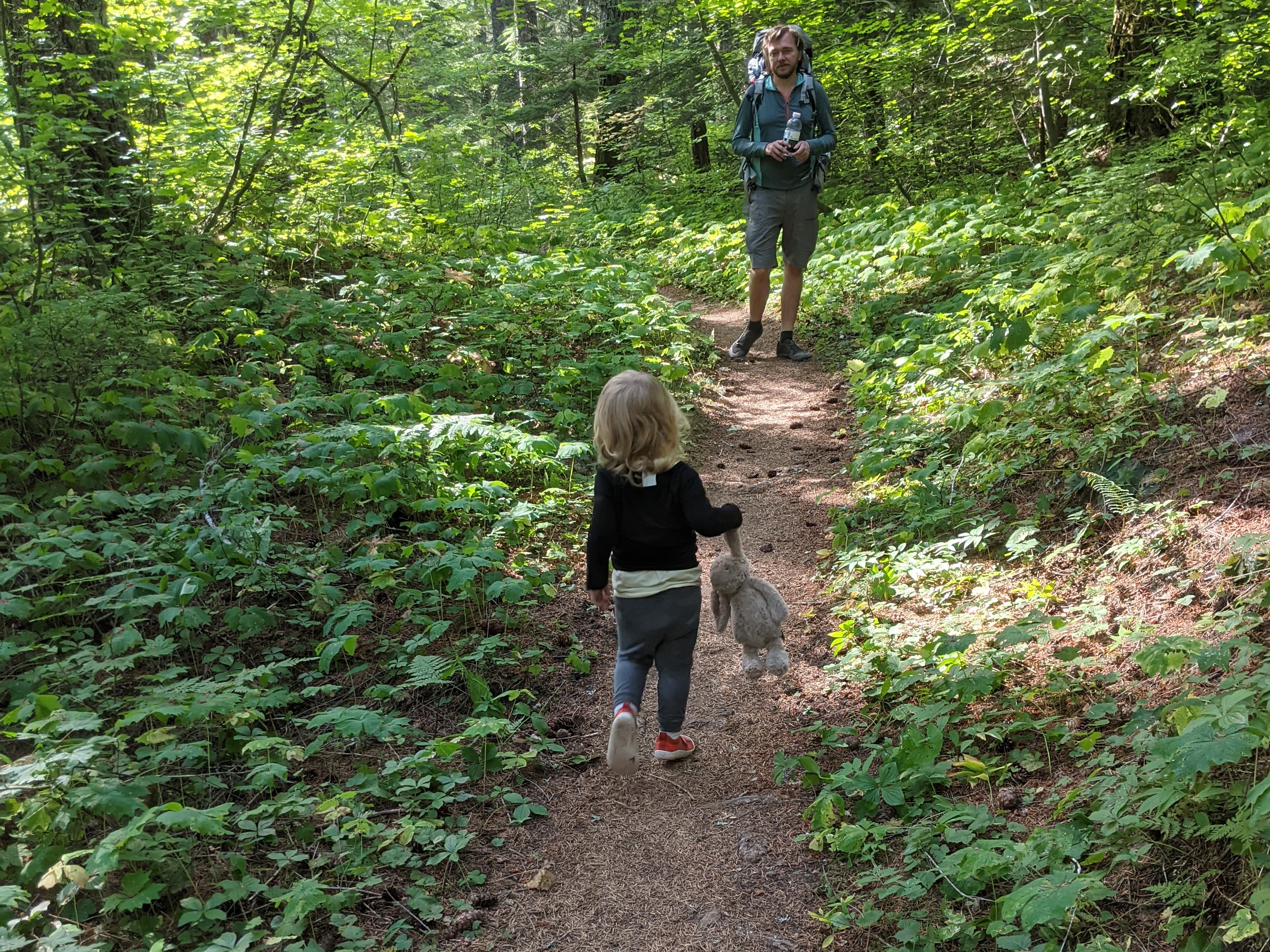
My only complaint is that the colors and patterns haven’t been interesting enough to hold her attention as she’s gotten older. When faced with rainbow sparkle galoshes that light up at the heel or sequined loafers embroidered with cat faces (two actual pairs of shoes in current rotation), there is some negotiating to get her to wear the Vivobarefoots, even though she knows those are the ones where she can run the farthest and the fastest. Kids have more adventurous fashion aesthetics than their parents, and it would be great if the barefoot shoe options available reflected that.
Other Brands in the Barefoot World
One barefoot shoe I was surprised to find out was fine from the experts I spoke to were Whitins, a budget Amazon brand. While these shoes fall apart faster than more robust models like Vivobarefoot and Xero shoes, they may be a good first pair for someone who is on the fence and doesn’t want to commit to a larger outlay upfront.
I have tested Lems shoes in the past and found them to be stylish and comfortable, especially if you are looking for a robust waterproof work boot. The downside to their shoes is that they have a higher stack height, basically across the board, which can prevent you from engaging with ground feel.
Bedrocks are another popular minimalist sandal. While I have enjoyed testing them in the past, and have found their toe-thong approach superior to Luna, the actual footbed material can be uncomfortable to walk on for extended periods. Luna likewise makes an excellent sandal, but the nylon webbing on their toe thong tends to twist over time.
The original Merrell Trail Glove was what I wore on my thru-hike of the Pacific Crest Trail, and I keep hoping their newer barefoot shoes will match that initial impression. Unfortunately, this hasn’t been the case. The Trail Glove has undergone numerous iterations, resulting in something closer to a traditional running shoe with arch support and a foam midsole. Their Vapor Glove is a better choice, with a lower stack height and no midsole. This shoe may work for individuals with a very narrow foot (the Vapor Glove is too narrow to allow for proper toe splay for average-width feet), but be sure to check that the shoe hasn’t suddenly sprouted arch support or a heel drop when purchasing a new iteration.
Altra is frequently described as a minimalist shoe. This is not an accurate description, and Altra, when I spoke to them for my story on Altra versus Hoka, told me that they do not see themselves as a minimalist shoe company. While their shoes, particularly the Lone Peak, share many important characteristics, including a wide toe box, zero heel drop (what Altra calls “balanced cushioning”), and no rocker bottom, the substantial foam midsole prevents users from experiencing proprioception, a key tenet of barefoot shoes. However, some individuals who are attempting to transition while race training (which is not recommended by the experts I spoke with), have had luck incorporating their Superior shoe into their training.
More recently I tried out Peluva, which advertises itself as a zero-drop shoe. This is sort of correct: there is zero drop between the midfoot and the heel. However, there is a 4mm drop between the toes and the midfoot. So while I don’t experience any sort of elevation while standing, when walking I feel slightly pitched forward at all times. Peluva’s explanation for this is that removing 4mm at the forefoot helps to improve articulation of the toes. This may well be true, but it’s pretty distracting if you are used to wearing any kind of a typical barefoot shoe and, in my admittedly limited experience with them thus far, is causing me to pitch forward in my walking gait compared to similar toed shoes.
What Is a Barefoot Shoe?
Since the term “barefoot shoes” is an oxymoron, let’s start with the most obvious question: if barefoot shoes are so great, why do I need shoes at all?
If you are somewhere like the beach or walking across a pristine grassy meadow, then please take your shoes off. Being completely barefoot feels great, and if you’ve been walking around your house and yard with shoes on, this is probably where you should start. However, most of the time, you are going to want something between your foot and the ground. In the natural environment, there are rocks, thorns, and all manner of things that can puncture or injure your foot. In the built environment it’s even worse. When I was first running with Vibram FiveFingers around New York City my route took me down a bridge that was regularly littered with broken glass. The Vibram outsole protected my feet just fine. Please, do not attempt to transition to barefoot shoes by ditching shoes altogether.
So what makes a shoe a barefoot shoe? At its most basic, barefoot shoes are trying to get out of the way of the natural biomechanics of the human body. “The body knows what it’s doing,” said Wadley. “Once you get the shoe out of the way, the body will control movement.” So it was no surprise that, in my discussions with physical therapists, pedorthists, and barefoot shoe designers, they all agreed on the general characteristics. However, there was one spot where there was some disagreement.
Zero Drop
The heel drop of a shoe refers to the difference between the height of the shoe at the forefoot and the heel. Traditional running shoes typically have a heel drop between 4mm and 12mm, and have been as high as 14mm. While people traditionally think of higher heel drops as providing extra cushioning for heel strikers, the reality is that it’s often used to reduce the load on your Achilles tendon and calf muscle. (This can have the effect of shortening or weakening your Achilles tendon over time.) However, heel drops also change the biomechanics of how you stand and walk. With a barefoot shoe, there is no difference between the stack height at the forefoot of the shoe and the heel of the shoe, which is referred to as “zero-drop.” “Half of transition is about the posterior change,” said Socha. “How do we take you from your 12mm shoe to a 0mm shoe.”
If you’ve been wearing heels or shoes with large heel drops for years, it may take some time to get down to a true zero drop shoe — Socha told me he frequently uses shoes from Topo, most of which have a 4mm drop, to help ease clients who are coming down from the most extreme examples.
Wide Toebox
“The foot is narrowest at the heel and widest at the toes, creating a triangular shape,” Davis told me. “At least, it’s supposed to be: for some people, years of wearing shoes with narrow toe boxes can lead to a ‘diamond-shape’ foot, where the toes point inward. Barefoot shoes will have a wide toebox that allow your toes to spread out naturally.”
Toe splay is important for both balance, creating a tripod with your big toe, pinky toe, and heel, and forward propulsion.
Flat, Flexible Sole
Barefoot shoes generally have soles that are so flexible that you can roll them up into a spiral. This allows your foot to roll through the gait cycle uninhibited. For walking, this means landing on your heel and pushing off with your toes. For running, this means landing on your forefoot, with your toes bent, touching down with your heel, and then pushing off again. In addition to lacking this flexibility, some traditional-style running shoes also feature a banana-like curve to the bottom, and occasionally just the toes, which is meant to mimic this portion of the gait cycle without engaging the feet themselves.
No Arch Support
People are used to thinking of their arch as a structural element of their foot, but Davis told me that the arch has 10 muscles in 4 layers “that help to control the defamation of the arch to provide that control of your foot.” Arch support in shoes inhibits these muscles from controlling your foot as it pronates and supinates during the gait cycle and, over time, weakens them. Barefoot shoes do not have arch support, so that these muscles are uninhibited, and can strengthen over time and function naturally.
Low Stack Height
The biggest variable between barefoot shoes is stack height, which refers to the mid and outsole thickness. For years, the best barefoot shoes were seen as the ones with the lowest stack heights, and some of the experts I spoke with maintained that this is still the case. “A minimalist shoe doesn’t have a midsole stack height,” Davis told me. “The less the better.” In her experience, there is a risk that individuals will carry over bad habits if they have a so-called barefoot shoe with a higher stack height. When I spoke to Wadley at Xero Shoes, however, he saw this as more of a spectrum. “There are varying levels of thinness,” he told me. “You don’t have to be paper thin. Even up to 12 millimeters of stack height, you still feel the ground a lot better than many other brands out there.” Socha often has clients purchase two pairs of shoes, one with a higher stack height and one that is more minimal, so that they can more quickly acclimatize their feet to barefoot shoes.
The reason this is an important issue is something called “proprioception.” This is your body’s ability to perceive location, force, and movement: think of trying to handle an object with a gloved hand versus a bare hand. Your feet have a huge number of nerve endings in them, and your body will take the information provided by your feet as you walk or run and adjust your locomotion to minimize stress on the body. The more you can feel the ground, then, the bigger the benefit. The downside to the lowest stack heights are that if you’ve been used to walking on 25mm of foam, then switching to nothing but 5mm of rubber can feel downright uncomfortable.
Typically individuals who have been wearing barefoot shoes for some time will gravitate toward thinner models (as they will experience that as the most comfortable), while people who are just getting started prefer a bit more cushioning in their shoes while they are building up their endurance. You may also prefer a slightly higher stack height for terrain that is particularly uncomfortable, such as sharp rocks. It’s important to note that a “thicker” shoe for a barefoot shoe might only be a few millimeters of difference: you should still be able to feel the ground, just not experience it as uncomfortable. For daily, casual wear, you want something that is no more than 10mm, and ideally less.
FAQs
Barefoot shoes have been shown to strengthen the muscles in your feet, such as in this randomized controlled trial.
You can work your way up to wearing barefoot shoes all day, but if you are experimenting with using barefoot shoes for the first time, ease your way into it slowly. Start with 10 minutes a day, and build your way up from there.
According to Davis, people who don’t have good sensation in their feet, have diabetes, or have any kind of peripheral neuropathy (characterized by numbness, pain, or weakness in the feet) should not use barefoot shoes. She also doesn’t recommend it for people who have arthritic feet. For individuals dealing with a musculoskeletal injury, like plantar fasciitis, you should first let the injury heal before working on strengthening the muscles in your feet by slowly introducing barefoot shoes. Socha further said that certain individuals with unusual conditions, like Danlos Syndrome, or who have permanently deformed feet, should not attempt to wear barefoot shoes.
It is also important to not transition to barefoot shoes while you are preparing for a major athletic activity, such as a marathon or a thru-hike. Each individual is different, and it often takes longer than expected to strengthen your feet in these shoes. Doing too much too quickly will lead to injury. Choose a time where you are dialing back on your physical activity (such as after marathon season) to start your transition process.
Individuals using barefoot shoes can expect to experience increased fatigue in their feet, specifically their arches, and their calves. Start slowly, and as your muscles strengthen, this will diminish and eventually disappear.
Barefoot shoes are a great choice for walking. However, if this is your first time wearing barefoot shoes, it’s important that you give your feet time to strengthen. Start with a short activity and then gradually increase your usage over time.
There are several benefits to incorporating barefoot shoes into your daily routine. Just walking in them has been shown to strengthen your feet, even without engaging in other foot strengthening activities. They can also help you learn to lessen the force with which you strike the ground when walking or running, reducing the overall impact on your joints.
Whether you wear socks with barefoot shoes is an individual choice. Some individuals I talked to, including Socha, expressed concern that overly tight socks prevent toes from splaying correctly; others, such as Orton, thought it was a matter of personal preference. After talking to both, I tried ditching my socks for casual wear and daily runs: turned out, I loved not wearing socks. My advice is to try it both ways and see which one you prefer.
It is very common for individuals to experience some discomfort when they start using barefoot shoes. This is your body’s way of telling you to take it slow; if walking for 10 minutes in barefoot shoes causes your feet to fatigue, then don’t walk farther than that. Over time your feet will strengthen and you will be able to go farther and for longer. Don’t push through the pain, as this may lead to injury.
If you are wearing barefoot shoes for the first time, start out very slowly. Take a 10 minute walk on the first day. Evaluate how you feel after the walk, and how you feel the next day. Expect to experience soreness in your feet and lower legs. As your feet strengthen, this will diminish and you will be able to increase your mileage. Many people will eventually find that they can transition full time to barefoot shoes, but this can take a long time.
Yes, you can wear barefoot shoes on concrete; however, you may find that your feet and legs fatigue more quickly than when you walk on softer ground, like trails.
Atra does not see themselves as a minimalist shoe company and most of the barefoot experts I spoke to do not see them as minimalist shoes. There was, however, some disagreement as to whether or not they were a useful tool for transitioning to barefoot shoes, with Davis saying that they are likely to contribute to poor form (especially for runners), while others, such as Socha, saw them as a useful transition tools for individuals who would otherwise be using a running shoe with a larger heel drop or arch support while strengthening their feet through daily walks.
Final Thoughts on the Best Barefoot Shoes
Something that can get lost in all the discussion about musculoskeletal benefits or proper transition strategies is that barefoot shoes are just more fun. It’s like taking off your shoes at the end of a long day, except your feet get to feel that freedom all the time. If this is your first pair, congratulations: you’re in for a treat.
Best Overall: Vivobarefoot Primus III (Men’s) (Women’s)
Most Comfortable: Xero HFS II (Men’s) (Women’s)
Best for Wide Feet: Freet Feldom (Unisex)
Best Ground Feel: Vibram FiveFingers KSO EVO (Men’s) (Women’s)
Best Sandal: Xero H-Trail (Men’s) (Women’s)
Best for Kids: Vivobarefoot Primus Sport (Unisex)
